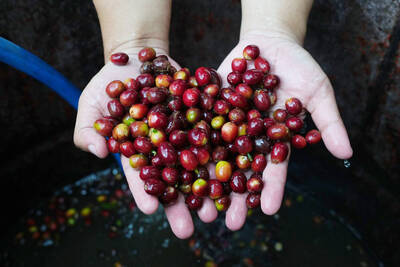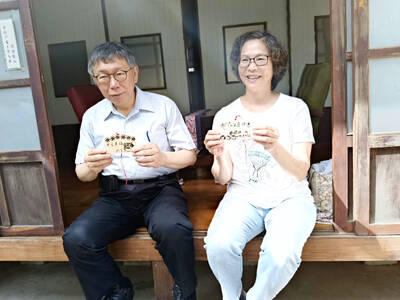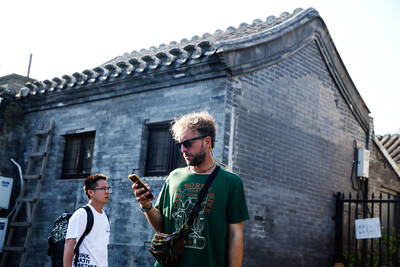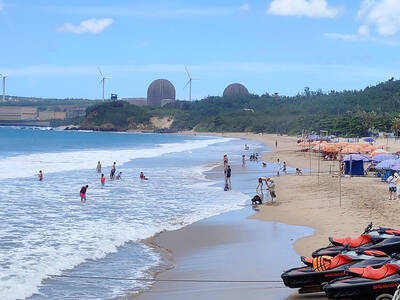Founded in 2002, the Taishin Art Awards (台新藝術獎) acknowledges achievements in the sphere of visual arts, performing and interdisciplinary arts. According to the Taishin Bank Foundation for Arts and Culture (台新銀行文化藝術基金會), the award ceremony “aims to encourage Taiwanese contemporary arts and culture through the assessment, evaluation and underwriting of local arts” as well as “expanding Taiwanese arts and stimulating cultural creativity worldwide.”
Now in its 22nd year, the annual award ceremony is acknowledged as one of the most prestigious of its kind in the Asia-Pacific region.
THE CEREMONY

Photo courtesy of Taishin Bank Foundation for Arts and Culture
This year’s event was held on Saturday on the second floor Taishin Tower in Taipei’s Daan District (大安).
Congregating on a wet and windy afternoon, members of the media alongside figures from the art world were grateful to step inside and rub shoulders ahead of the award ceremony opening speech courtesy of Chairman of the Taishin Bank Foundation for Arts and Culture Simon Cheng (鄭家鐘).
Cheng said that over the past 22 years, the Taishin Arts Award had actually become more significant than the prize itself, describing it as “a zoom lens, constantly moving between wide angle and close-up as it surveyed various artistic landscapes until finally focusing on the meaning of a given year.”

Photo courtesy of Taishin Bank Foundation for Arts and Culture
Cheng said this had made the award ceremony a driving force in the “diverse development of Taiwan’s contemporary art scene.”
With a total prize of NT$3.5 million up for grabs, anticipation was palpable among the directors, actors, writers and producers in attendance. According to the organizers, the winners of the three major awards were chosen from 17 shortlisted works after three days of intensive meetings by a selection committee chaired by scholar Lin Ho-yi (林鶴宜).
After the host Chen Chia-kuei (陳家逵) welcomed the audience and talked us through the afternoon’s program, the first of three major awards was announced.

Photo courtesy of Taishin Bank Foundation for Arts and Culture
THE AWARDS
The Visual Art Award was won Ky Tuc Xa (宿舍Ky Tuc Xa), a film by Tainan-based Your Bros Filmmaking Group concerning the lives of Vietnamese migrant workers in Taiwan. The film is actually a re-enactment of an incident that took place in New Taipei City’s Sijhih District (汐止) in 2018, when more than one hundred Vietnamese workers went on strike due to insufficient dorm space, and lacking bathroom facilities, after having repeatedly reported these issues to their supervisor. The entire process was live-streamed online.
In Taipei to accept the award was Tien Jung-yuan (田倧源) who designed sets and recorded sound for Ky Tuc Xa.
“I can’t wait to take the high-speed train back to Tainan and share the good news with the other members of the team,” he told the Taipei Times.
The Performing Arts Award was given to Taipei Seagull Theater for their theatrical production titled Who’s Koxinga? (國姓之鬼).
Koxinga (Cheng Cheng-kung (鄭成功) was a Fujianese pirate turned military leader that defeated the Dutch, who had established a colonial outpost in Tainan . He has since become a folk hero, worshiped as deity in coastal communities and appearing in everything from video games to novels.
According to the Taishin Arts Award selection committee, the reason why Taipei Seagull Theater’s take on the Koxinga’s legend was noteworthy was due to its contemporary resonance, as actors portraying a theater troupe living 300 years ago while periodically expressing thoughts in the present.
Playwright and director Sung Hou-kuan (宋厚寬) saw the actors as “a corridor connecting the present and the past as well as the space between dreaming and wakefulness.” The metafiction, then, was able to comment on “the decline of traditional theater” in our time “and its much-needed transformation” by presenting a play within a play within a play.
The final and most prestigious prize is the Annual Grand Award which, this year, was given to a collaborative effort between approaching theater (窮劇場) and Gang-a Tsui Theater (江之翠劇場).
Apostating Time (感謝公主), which ran in the Taiwan Traditional Theater Center (TTTC) in December last year, blends the traditional opera Zhu Bian — the story of a Southern Song envoy who was imprisoned in a country called Jin where he married a princess — with a parallel story set in 1950s Taiwan during the White Terror period when the island was under martial law. The dual narratives are weaved together “transcending space and time,” taking audience members on a journey through what is described as “the archetypes of Pan-Chinese spiritual nostalgia and its emotional roots.”
Apostating Time is an allegory of modern Taiwan and the current debate associated with Taiwanese identity. It won the top prize for exploring contemporary themes in imaginative, non-linear ways, provoking audience members to contemplate how we are to understand conflicting and/or abandoned beliefs and emotions.

Climate change, political headwinds and diverging market dynamics around the world have pushed coffee prices to fresh records, jacking up the cost of your everyday brew or a barista’s signature macchiato. While the current hot streak may calm down in the coming months, experts and industry insiders expect volatility will remain the watchword, giving little visibility for producers — two-thirds of whom farm parcels of less than one hectare. METEORIC RISE The price of arabica beans listed in New York surged by 90 percent last year, smashing on Dec. 10 a record dating from 1977 — US$3.48 per pound. Robusta prices have

The resignation of Taiwan People’s Party (TPP) co-founder Ko Wen-je (柯文哲) as party chair on Jan. 1 has led to an interesting battle between two leading party figures, Huang Kuo-chang (黃國昌) and Tsai Pi-ru (蔡壁如). For years the party has been a one-man show, but with Ko being held incommunicado while on trial for corruption, the new chair’s leadership could be make or break for the young party. Not only are the two very different in style, their backgrounds are very different. Tsai is a co-founder of the TPP and has been with Ko from the very beginning. Huang has

A few years ago, getting a visa to visit China was a “ball ache,” says Kate Murray. The Australian was going for a four-day trade show, but the visa required a formal invitation from the organizers and what felt like “a thousand forms.” “They wanted so many details about your life and personal life,” she tells the Guardian. “The paperwork was bonkers.” But were she to go back again now, Murray could just jump on the plane. Australians are among citizens of almost 40 countries for which China now waives visas for business, tourism or family visits for up to four weeks. It’s

A dozen excited 10-year-olds are bouncing in their chairs. The small classroom’s walls are lined with racks of wetsuits and water equipment, and decorated with posters of turtles. But the students’ eyes are trained on their teacher, Tseng Ching-ming, describing the currents and sea conditions at nearby Banana Bay, where they’ll soon be going. “Today you have one mission: to take off your equipment and float in the water,” he says. Some of the kids grin, nervously. They don’t know it, but the students from Kenting-Eluan elementary school on Taiwan’s southernmost point, are rare among their peers and predecessors. Despite most of